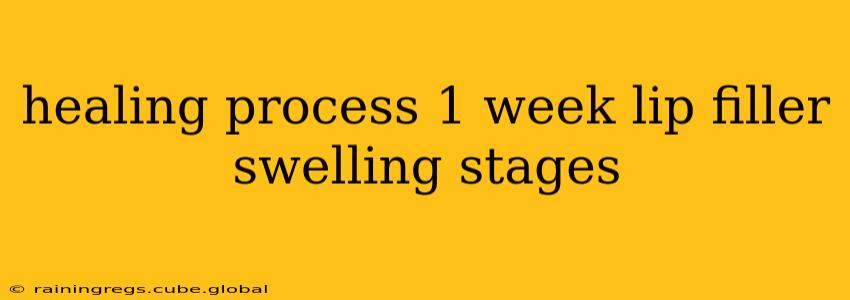Getting lip fillers is a popular cosmetic procedure, but understanding the healing process is crucial for managing expectations and ensuring optimal results. This post details the typical swelling stages you can expect during the first week after lip filler injections, addressing common questions and concerns.
What are the typical swelling stages during the first week after lip filler?
The swelling after lip filler injections varies significantly between individuals. However, a general timeline illustrates the typical progression:
-
Day 1-2: Immediately following the procedure, you'll likely experience noticeable swelling. This is a normal inflammatory response to the injection. The lips might feel tender and slightly firmer than usual. Some bruising is also possible.
-
Day 3-4: Swelling usually peaks around day 3 or 4. The lips may appear significantly larger than desired, and you might experience increased tenderness. Ice packs can help manage discomfort and reduce swelling.
-
Day 5-7: By day 5, you should start noticing a gradual reduction in swelling. While some puffiness might remain, it will be less pronounced than in the previous days. The lips should feel less tender, and the firmness will start to subside.
It's crucial to remember that these are general timelines, and individual experiences can vary depending on several factors including:
- Amount of filler injected: Larger volumes of filler will generally lead to more significant swelling.
- Type of filler used: Different filler formulations have varying swelling profiles.
- Individual response: Everyone's body reacts differently to injections.
- Technique used by the injector: An experienced injector can minimize swelling through precise injection techniques.
How long does swelling last after lip fillers?
While the most significant swelling subsides within the first week, complete resolution can take several weeks, sometimes even up to a month or more. Many people find that the majority of the swelling is gone by two weeks, leaving a more natural-looking result.
Is it normal to have a lot of swelling after lip fillers?
Yes, a degree of swelling is completely normal after lip filler injections. The extent of the swelling depends on factors previously mentioned, but significant swelling in the initial days is a common experience. Don’t panic; it’s part of the healing process.
What can I do to reduce swelling after lip fillers?
Several strategies can help minimize swelling and discomfort:
- Ice packs: Apply ice packs to your lips for short intervals (15-20 minutes at a time) during the first few days.
- Elevation: Keep your head elevated when sleeping to reduce fluid accumulation.
- Avoid strenuous activity: Physical exertion can increase swelling.
- Follow your injector's aftercare instructions: Your injector will provide specific recommendations tailored to your procedure.
- Arnica: Some people find that taking arnica supplements can help reduce bruising and swelling. (Always consult with your doctor or injector before starting any new supplements.)
- Avoid alcohol and smoking: These can hinder the healing process and potentially increase swelling.
What should I do if my lip filler swelling is excessive or doesn't improve?
If you're experiencing excessive swelling, significant bruising, or any other concerning symptoms, contact your injector immediately. They can assess the situation and provide guidance or necessary intervention. Unusually prolonged or severe swelling may indicate a complication, necessitating professional medical attention.
When should I expect my final results after lip filler injections?
It's crucial to be patient. While the initial swelling subsides within the first week, the final results are usually visible after several weeks, once all the swelling has completely resolved. This allows the filler to settle naturally into the lip tissue, revealing the true shape and volume.
Remember, selecting a qualified and experienced injector is crucial for minimizing risks and achieving the best possible outcome. Always consult with a medical professional before undergoing any cosmetic procedure. This information is for general knowledge and should not be considered medical advice. Always follow your healthcare provider's instructions.
